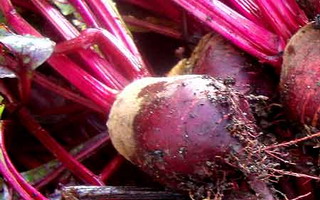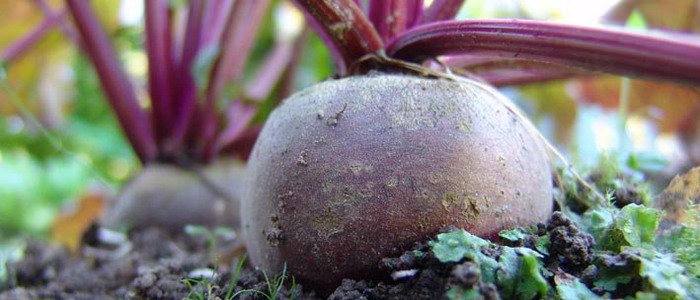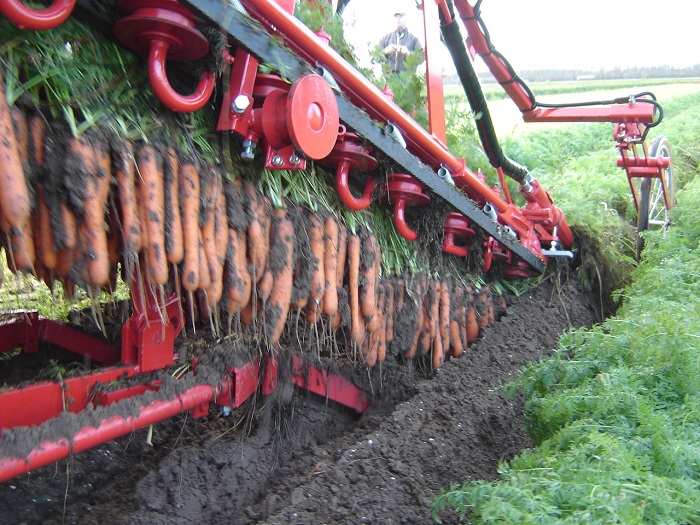When to harvest carrots. When is it better to harvest carrots and beets
Cleaning time
The main rule of keeping carrot harvest is timely and proper cleaning. Carrots are not afraid of frost, so you can harvest this root crop until mid-October. In the soil, carrots can tolerate frosts, if before this, take its tops to the ground, but being in the frosty air negatively affects it. Digging root crops even from snow is practiced, this method allows them to cool before long-term storage.The reduced average daily temperature slows down the metabolic processes in carrots, it cools and this favorably affects storage. It is mid-September - early October that is considered the optimal time for harvesting. If weather forecasts predict rains, then dig up carrots before the rainfall season. During prolonged autumn rains, carrots become saturated with moisture, become tasteless and crack.
Harvest dates vary depending on several factors:
Purpose of cultivation;
- weather;
- general condition of plants;
- growing region;
- meteorological forecasts;
- Features of agricultural technology;
- the maturity of a particular variety;
- the size of the root crop.
Choose good and warm weather for harvesting carrots when the soil is dry. Depending on the variety, the maturity of the red beauty is different. Typically, carrot harvest times are indicated on a bag of seeds. Harvesting ahead of time is not worth it, as carrots do not have time to ripen and accumulate enough sugars, which will negatively affect its taste. Overexposed carrots in the garden have an excess of amino acids and sugars, and this makes it a treat for mice, carrots fly larvae. You can prepare carrots for harvesting already at the end of August, take the tops in one direction, closing the carrots that appeared from the ground.
Additionally, when harvesting carrots, be guided by the color of the tops, as soon as it begins to turn yellow - the root crops are ready for harvesting.

Tops removal
A few days before digging up the carrots, stop watering it. It is also recommended to cut the tops, leaving the carrot tail about 5 cm long. This procedure allows you to preserve the juiciness of the root crop, which disappears with the rapid growth of the tops.After digging the carrots, the entire tops are completely removed in two stages. We remove the tops necessarily so that it does not take on useful substances. First, cut or unscrew the tops just above the root head. The next day, the head is completely cut off, including the growth point (cut thickness 0.5 - 1 cm). Note that the cut should be smooth and even.
Cardinal pruning significantly increases the shelf life of carrots, while it does not germinate in the winter, the fruits do not wither and do not dry out.
How and how to dig out carrots
Vegetable growers with experience suggest pulling carrots manually by the tails. When there is not enough strength to get the root crop out of the ground, you can dig up the carrots with a shovel or blunt pitchfork with flat teeth, which damage the carrots less. Use the tools carefully, otherwise they may leave a mark on the root crop, and it will subsequently begin to rot. When pulling a carrot with your hands, hold it with one hand near the ground, grab it firmly with the other and pull the tops.Wipe off severe dirt and lumps of earth on the root crop with a dry rag or palm. It is strictly forbidden to wash, scrape with a sharp object, a knife, and knock down the earth, thereby damaging and spoiling vegetables.
Drying
To prepare carrots for long-term storage after trimming, drying is required. If the weather is sunny and dry, then carrots can be dried in 2 - 3 hours. When the harvest took place on a cloudy day, you should carefully dry the root crops in a cool room for 1-2 days. After drying, we will secondly clean the carrot from the remnants of the earth. If dirt remains on root crops, do not try to remove it completely, do not damage them.Quarantine the carrots, place them in a room with a temperature of 10-15 degrees for a week. During this time, the places of cuts in the area of \u200b\u200bthe carrot head will be tightened, and diseased and spoiled root crops will let you know.
Sorting
After drying, just before cleaning the store, carrots should be inspected and sorted out. Even during the digging of the crop, carrots can be cut with the careless movement of a shovel or harmful insects. Inspect each carrot for rot, signs of wilting, or damage.Harvest carrots ready for storage.
When is it better to harvest carrots and beetsSome vegetable growers are sure that carrots can be harvested at any convenient time, almost until mid-October, since this vegetable crop not afraid of frost. Others believe that it is necessary to adhere to certain dates when to harvest carrots, otherwise the root crops will become woody, less juicy, or even begin to rot.
So who is right? When do you need to collect carrots? The following factors affect the harvesting time:
- what types of carrots grow on your beds - early ripe, mid-ripening or varieties intended for winter storage;
- biological features cultivated varieties;
- growing goals;
- plant condition;
- weather.
Having correctly determined the appropriate period when you need to harvest carrots, you will get high-quality root crops with a pleasant taste and attractive appearance. Timely harvesting will also favorably affect the nutritional and keeping quality of root crops.
Early and late carrots - when to collect root crops of different varieties?
FROM long ago in Russia it was believed that the best time to harvest carrots and other root crops ended on September 13th. After this date, the beds should have remained clean. This has a certain meaning: when the temperature drops to +4 degrees, the root crops stop growing, and at a temperature of -3 degrees there is a high risk of carrots getting damaged by gray rot, as a result of which its keeping quality will greatly worsen. Therefore, it is better to dig up carrots before the onset of stable autumn frosts, a maximum until the end of September. But it is not recommended to take root vegetables out of the ground too early, because they have been in quite warm soil for a long time — sudden movement into a cool cellar or basement can lead to significant storage losses.
Of course, this applies only to varieties of late ripening. When picking carrots of mid-ripening varieties, you can calculate yourself - the ripening period lasts from 80 to 110 days. Additional signs of ripening root crops will be yellowed lower leaves. It is not worth it to overdo the mid-ripening carrot in the ground, its taste qualities from this can only worsen.
Carrots with early ripening, as well as the one that was planted before winter, begin to be harvested in the middle of summer, making vitamin salads from it and eating fresh - it is very tasty and juicy. To obtain bundled carrots, you can collect root crops when they reach a diameter of more than 1 cm. If you skip the period when you need to harvest early-ripening carrots, leaving them in the ground for a long time, it will lose its bright taste and attractive appearance: root crops can crack.
How to harvest?
So, you have decided for yourself when it is better to harvest carrots. Now you can proceed directly to the harvesting process. Short and medium root vegetables are harvested by hand: holding the carrots in the ground with one hand, and grasping the tops firmly with the other. Long carrots should be carefully dug with a pitchfork or a shovel so as not to injure or break the root crops. Having lifted the top layer of the earth with carrots, remove it, holding by the tops.
There is an erroneous opinion that carrots, together with tops, should be left on the field for several days, so that all nutrients from the aboveground part of the plants went into the underground part. In reality, everything happens just the opposite: the tops pull all the juices and nutrients from the root crop, from which it begins to dry out. Therefore, when harvesting carrots without putting off, cut the tops as soon as the earth on the roots is slightly dry. Leaves can only be left on a bunch carrot, and it is better to leave the petioles no more than two cm.
The tops can be twisted by hand or cut together with the top of the carrot head up to 2 mm. This will help to significantly increase the shelf life of carrots, as the tops will not begin to germinate, causing the root to dry out and reduce its nutritional value.
Now you know when to remove carrots from the garden, and how to properly clean. Remember that for storage enough ripened carrots should be sent so that important biological components and carotene can accumulate in it. It is also important not to allow when harvesting mechanical damage to root cropsotherwise they will be stored badly.
If you still have doubts about when to harvest carrots from your beds, try pulling out a few root crops and visually assess their maturity or taste. Though not the first time, but soon you will learn to reliably determine the most optimal termwhen to clean the carrots!
aND THERE IS ANOTHER OPINION
Experienced vegetable growers are advised not to rush with the harvesting of carrots, since root crops (in middle lane Russia) is observed in September in the second half of the month. In the north of the country, frosts are early, so carrots are harvested there in early September. The fact is that it must be removed before frost on the ground. To decide on a question, it should be removed or not, or it can be left in the ground for 2-3 weeks, they dig one carrot from the ground.
If she began to grow on the sides with small roots - it's time to dig.
It is better to dig out these root crops with garden pitchforks, but not with a shovel. They are dug up, and then pulled out of the ground, holding the tops, while making sure that the carrot does not break off the tip, because otherwise it will not withstand long-term storage, and it will need to be used as soon as possible for food. It is advisable to shake the ground from root crops with your hands in order to avoid mechanical damage.
They clean the carrots from the garden, carefully cut the leaves (tops), because if it grows, it will suck out all the juices and leave to dry: it can be on a table or on a film. Carrots are stored perfectly in boxes, sprinkled with sand mixed with lime - 10 parts sand and 1 part slaked lime. You can dip them into the clay “talker” and dry them thoroughly.
First of all, beets are harvested from root crops.
This vegetable is extremely rich in vitamins and minerals, and also underlies quite effective diets. The winter table can’t do without it. Beet harvesting time plays an important role.
This is usually September. It should be noted that in regions where the fall is long and warm, beet harvesting is possible until mid-October. Also in the earth you can leave small-sized root crops. The most important thing is to remove the beets before the onset of frost, otherwise it will be poorly stored, wrinkled, will begin to rot, but the most important thing is that it will lose its quite pleasant taste.
And before the first frosts, you should not dig it out, and the lower yellowed leaves do not mean at all that the beets have stopped growing, because they dry constantly when new ones appear. It is desirable to clean it in dry weather. The root crops grown by digging with the help of a shovel are removed from the soil, cleaned from the residues of leaves (tops) and earth on them. Here in this form it is ready for storage. For storage, sand or sawdust is suitable
Why can not you leave beets in the garden for a long time?
The timing of beet harvesting depends not only on physiological reasons, that is, maturation, the size of root crops, but also on the weather conditions of the area where it is grown. Especially it concerns late gradesdesigned for winter. Therefore, deciding whether to postpone or start harvesting this healthy vegetable It is necessary to take into account its features:
And further
Harvesting beetroot and harvesting beets for the winter
 Root crops are perfectly preserved. Therefore, many gardeners harvest beets for the winter. It is very undemanding to storage conditions. You can store the crop in bulk bins. The most suitable varieties for long-term storage are Podzimnaya, Peerless and Bordeaux.
Root crops are perfectly preserved. Therefore, many gardeners harvest beets for the winter. It is very undemanding to storage conditions. You can store the crop in bulk bins. The most suitable varieties for long-term storage are Podzimnaya, Peerless and Bordeaux.
Harvesting beets is carried out somewhat earlier than harvesting carrots. Its root crops are larger and protrude above the surface of the earth more. Therefore, they are more damaged by frost. Early ripening varieties ripen in July. By the time they are ready, root crops of the first quality class have a diameter of 5-10 cm. Root crops of the second quality class reach a diameter of up to 14 cm.
Harvesting beetroot is carried out when its leaves are yellowed and dried. Usually this is the end of August and the first half of September.

Root crops are very carefully, so as not to damage them, they are dug up with a pitchfork. Then hands are removed from the soil, cleaned of the remnants of the earth. After that, using a sharp knife, carefully, so as not to touch the root crop itself, they cut it off. The length of petioles after harvesting should be no more than 2 cm. After some time, after these sections harden, the crop can be removed for storage.
How to store beets - the best conditions for storing beets
To prevent the development of microorganisms, the crop should be treated with chalk. It is good to keep beets close by. This has a beneficial effect on that and on.

Root crops have a characteristic thick skin. It protects them from mechanical damage, and also reduces moisture evaporation. In addition, the vegetable has the ability to heal small scratches in its upper part. But the shelf life of such a crop is reduced to 4 months. If the heads have peeled skin, then the period is reduced to 3-4 months. Even less can lay crops damaged by diseases and insects. Even one sick head in the entire batch can kill a large number of other root crops. After collection, all the heads need to be carefully examined, and separate damaged, rotten and diseased specimens. Then air dry.
If the crop has no mechanical damage and is not infected, then it will calmly lie for 8 months. This means that with careful harvesting and under proper conditions, the crop can survive until the next year's crop. However, it will be kept fresh. The heads with diameters up to 10 cm are best preserved. The best humidity for the crop is 80-85%. And the best temperature is 2-3 ° C. Storage should be cool and dry. It should be protected from freezing. After it thaws, the heads will rot and become sick. It must be borne in mind that keeping quality can depend on growing conditions and on the characteristics of a particular variety.

There are many options for storing beets. The heads can be removed in plastic bags, which are then covered with sawdust or sand. Can be left in sand, peat, shavings or sawdust in dry and clean boxes. Large batches are well stored in containers with plastic liners. The containers on top are filled up to 7 cm with wet sand. They can be installed one above the other. With this method, the loss will be no more than 5%. But in this case, the temperature should be 0 ° C. If it rises at least a couple of degrees, the amount lost crop will increase significantly.
You can also remove root crops in the underground, cellar, pit, trench or in the basement. In trenches, the heads are covered with earth and covered with leaves.
If the collection was carried out using machines, then the heads are stored in bins. Bulks are leveled for better ventilation. Small heads are stored separately from large ones.
You can also use refrigerators for storage.
It would seem that harvesting carrots is such a simple matter that they can cope with it. small child. Pull yourself the ripe root crops from the garden and cut off the tops. But if everything had been so simple, gardeners would not have raised so many questions carrot harvesting, harvest dates and root crop storage technology.
But after all, on how much time and how accurately the crop of carrots is harvested, the taste qualities of root crops, their appearance and long-term storage ability. If you want a sweet, vitamin-rich, beautiful and smooth carrot that is resistant to various species rot, you need to not only sow the seeds at the right time and provide seedlings proper care, it is also important not to miss the time of picking carrots, dig it out without harming the root crops, and prepare it properly for winter storage.

Gardeners usually dig carrots the old fashioned way - manually using a shovel
Gardeners usually dig carrots the old fashioned way - manually using a shovel. In large farms, preference is given to mechanized harvesting of carrots using various harvesting equipment. Let us consider in more detail in what ways and with the help of which technologies harvesting of carrots can be carried out.
Video about the proper harvesting of carrots
Traditional picking carrots by hand
First of all, you need to correctly determine depending on which varieties you sowed. Early ripe varieties can be harvested after sowing after 2 months, mid-ripening - after 3 months, and late-ripening - after about 4 months. When harvesting carrots intended for winter storage, it is important to make time so that enough useful vitamins have already accumulated in the root crops, but the carrots have not yet had time to crack or rot from a long stay in the soil and frost. A sure sign that you can start harvesting is yellowed tops.
The technology for harvesting carrots is simple:
- remove dried lower leaves from plants so that they do not interfere with digging and pulling out root crops;
- dig a carrot with a shovel, holding the blade strictly upright and putting it in the ground 5 cm from the row, so as not to accidentally damage the root crops;
- holding a carrot near the ground with your hand, gently pull it with the second hand by the tops;
- fold the pulled root vegetables along the row so that the dirt on them dries out a little;
- having finished digging up the carrots, lightly peel the ground off it and cut the tops.

It is not worth digging up root vegetables immediately after rain, otherwise they may crack and become unsuitable for long-term storage.
Most auspicious days for harvesting carrots - the end of September, when the weather is dry for a long time. You should not dig up root crops immediately after rain, otherwise they may crack and become unsuitable for long-term storage. It is also not recommended to leave the dug carrots with the tops in the garden, as the tops will draw nutrients from the root. Place carrots with cut tops in storage boxes immediately.
Carrot harvesting methods
Enterprises that specialize in growing carrots on an industrial scale harvest mechanically using various types of combine harvesters. The timing of carrot harvesting varies and depends on the onset of full maturity of root crops - ripened carrots do not darken from a long stay in the fresh air.
Video about carrot harvesting methods
Before mechanical harvesting with a topper, the tops of carrots are removed, the crops are cleaned of weeds. Weed removal is especially important when harvesting with a top-lifting machine, as it automatically tracks a row of plants and can deviate to the side due to growing weeds.



